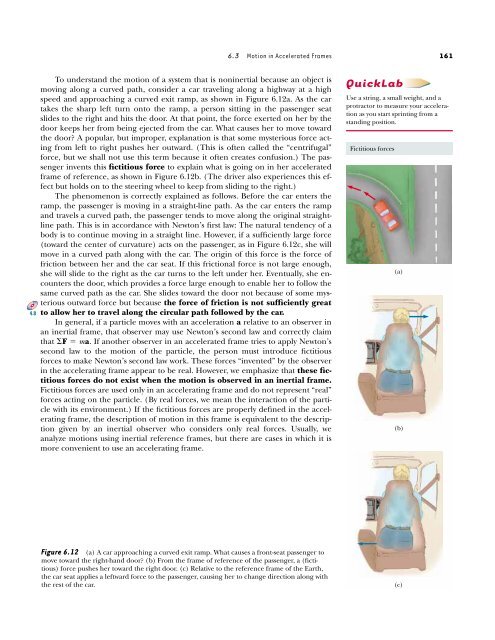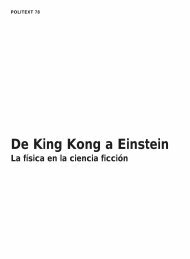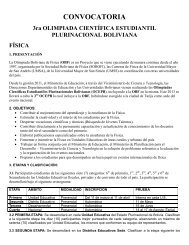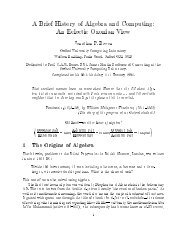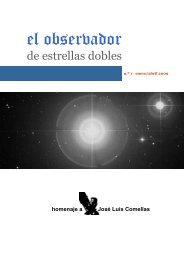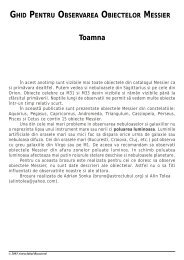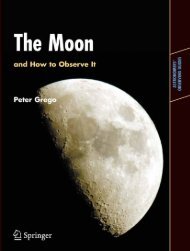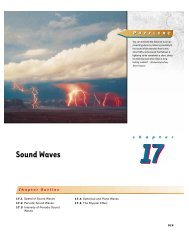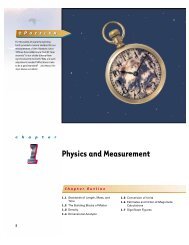Circular Motion and Other Applications of Newton's Laws
Circular Motion and Other Applications of Newton's Laws
Circular Motion and Other Applications of Newton's Laws
Create successful ePaper yourself
Turn your PDF publications into a flip-book with our unique Google optimized e-Paper software.
4.8<br />
To underst<strong>and</strong> the motion <strong>of</strong> a system that is noninertial because an object is<br />
moving along a curved path, consider a car traveling along a highway at a high<br />
speed <strong>and</strong> approaching a curved exit ramp, as shown in Figure 6.12a. As the car<br />
takes the sharp left turn onto the ramp, a person sitting in the passenger seat<br />
slides to the right <strong>and</strong> hits the door. At that point, the force exerted on her by the<br />
door keeps her from being ejected from the car. What causes her to move toward<br />
the door? A popular, but improper, explanation is that some mysterious force acting<br />
from left to right pushes her outward. (This is <strong>of</strong>ten called the “centrifugal”<br />
force, but we shall not use this term because it <strong>of</strong>ten creates confusion.) The passenger<br />
invents this fictitious force to explain what is going on in her accelerated<br />
frame <strong>of</strong> reference, as shown in Figure 6.12b. (The driver also experiences this effect<br />
but holds on to the steering wheel to keep from sliding to the right.)<br />
The phenomenon is correctly explained as follows. Before the car enters the<br />
ramp, the passenger is moving in a straight-line path. As the car enters the ramp<br />
<strong>and</strong> travels a curved path, the passenger tends to move along the original straightline<br />
path. This is in accordance with Newton’s first law: The natural tendency <strong>of</strong> a<br />
body is to continue moving in a straight line. However, if a sufficiently large force<br />
(toward the center <strong>of</strong> curvature) acts on the passenger, as in Figure 6.12c, she will<br />
move in a curved path along with the car. The origin <strong>of</strong> this force is the force <strong>of</strong><br />
friction between her <strong>and</strong> the car seat. If this frictional force is not large enough,<br />
she will slide to the right as the car turns to the left under her. Eventually, she encounters<br />
the door, which provides a force large enough to enable her to follow the<br />
same curved path as the car. She slides toward the door not because <strong>of</strong> some mysterious<br />
outward force but because the force <strong>of</strong> friction is not sufficiently great<br />
to allow her to travel along the circular path followed by the car.<br />
In general, if a particle moves with an acceleration a relative to an observer in<br />
an inertial frame, that observer may use Newton’s second law <strong>and</strong> correctly claim<br />
that �F � ma. If another observer in an accelerated frame tries to apply Newton’s<br />
second law to the motion <strong>of</strong> the particle, the person must introduce fictitious<br />
forces to make Newton’s second law work. These forces “invented” by the observer<br />
in the accelerating frame appear to be real. However, we emphasize that these fictitious<br />
forces do not exist when the motion is observed in an inertial frame.<br />
Fictitious forces are used only in an accelerating frame <strong>and</strong> do not represent “real”<br />
forces acting on the particle. (By real forces, we mean the interaction <strong>of</strong> the particle<br />
with its environment.) If the fictitious forces are properly defined in the accelerating<br />
frame, the description <strong>of</strong> motion in this frame is equivalent to the description<br />
given by an inertial observer who considers only real forces. Usually, we<br />
analyze motions using inertial reference frames, but there are cases in which it is<br />
more convenient to use an accelerating frame.<br />
Figure 6.12 (a) A car approaching a curved exit ramp. What causes a front-seat passenger to<br />
move toward the right-h<strong>and</strong> door? (b) From the frame <strong>of</strong> reference <strong>of</strong> the passenger, a (fictitious)<br />
force pushes her toward the right door. (c) Relative to the reference frame <strong>of</strong> the Earth,<br />
the car seat applies a leftward force to the passenger, causing her to change direction along with<br />
the rest <strong>of</strong> the car.<br />
6.3 <strong>Motion</strong> in Accelerated Frames 161<br />
QuickLab<br />
Use a string, a small weight, <strong>and</strong> a<br />
protractor to measure your acceleration<br />
as you start sprinting from a<br />
st<strong>and</strong>ing position.<br />
Fictitious forces<br />
(a)<br />
(b)<br />
(c)


